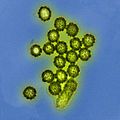- Clinical Technology
- Adult Immunization
- Hepatology
- Pediatric Immunization
- Screening
- Psychiatry
- Allergy
- Women's Health
- Cardiology
- Pediatrics
- Dermatology
- Endocrinology
- Pain Management
- Gastroenterology
- Infectious Disease
- Obesity Medicine
- Rheumatology
- Nephrology
- Neurology
- Pulmonology
FluMist Not Effective Vs H1N1 (Maybe): What Next?
What flu vaccine should you recommend this year for children over age 2? A look at the data . . .
H1N1 influenza virus particles. Surface proteins on the virus particles are shown in black. (Courtesy Wikipedia.)

COMMENTARY
The Advisory Committee on Immunization Practices (ACIP) recently reported that data from last year’s flu season show that Flumist (LAIV) was essentially totally ineffective in preventing H1N1 influenza (the pandemic strain).
Since the strain was unchanged in this year’s vaccine, does that mean Flumist won’t work this year as well?
The answer is unknown-just as the answer as to why the vaccine did not work well last year is unknown. Data showed Flumist had been effective against this same strain of influenza in the 3 previous flu seasons and even seemed to work a little better than the shot version (IIV), although the difference did not reach statistical significance. According to Medimmune, makers of Flumist, the pandemic strain is more susceptible to thermal degradation, so perhaps there was a problem in the cold chain during shipment or storage last year. Needless to say, Medimmune is working very hard to find an answer.
Interestingly, before this problem had been identified, the ACIP took the unusual-for-it approach and actually stated a preference for a specific vaccine. It recommended that, when possible, clinicians should use Flumist preferentially in children aged 2 to 8 over the inactivated form, (ie, the flu shot). This recommendation was based on data that showed significantly increased efficacy of LAIV as compared with the IIV. A number of studies suggest that efficacy difference is enhanced even more when a mis-matched strain circulates.
What should you recommend to your patients this year when they ask which vaccine you recommend for their child over the age of 2?
At first glance, one would think the ACIP would at least withdraw its preference recommendation for Flumist. It has not. While I am not privy to any internal discussion, I think I can explain why, at this time anyway, Flumist is still recommended.
As of September 28, 44 states had reported at least sporadic flu activity. You can see what is going on in your state here. This map is updated weekly. You can see what the circulating strains are here. As of the end of September, 71% of tested specimens were A strains and 29% B strains. Of the A strains, fewer than 3% were H1N1: the rest were H3N2. So, if this year’s Flumist turns out to again be ineffective in protecting against the H1N1 strains, it won’t really matter because of the low prevalence of circulating H1N1. Keep in mind, this can change.
I would suggest you keep your eye on the above 2 Web sites so that you can intelligently answer when your patients ask, “Which vaccine should I give my child?”
Disclaimer: Dr Brenneman is on the Speakers’ Bureau for Medimmune. The above commentary represents his views only and have not been reviewed or endorsed by Medimmune.
